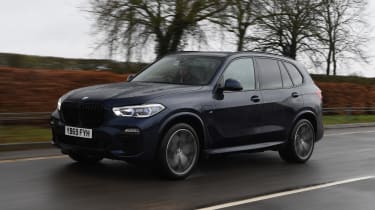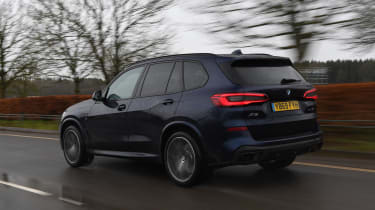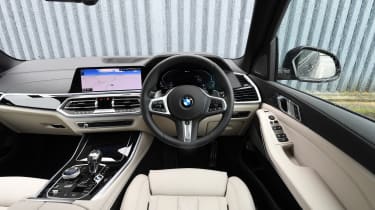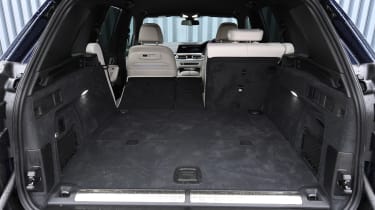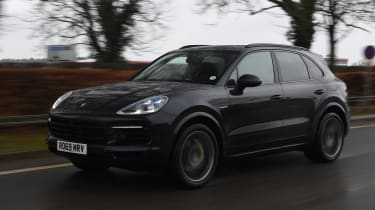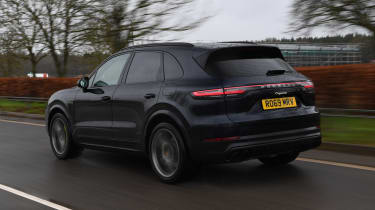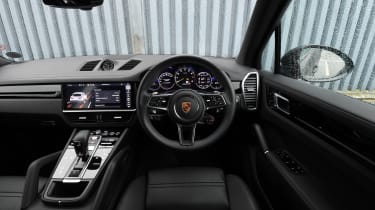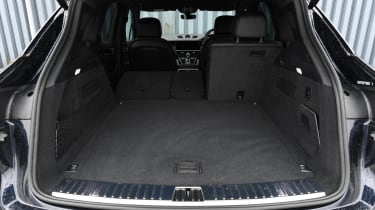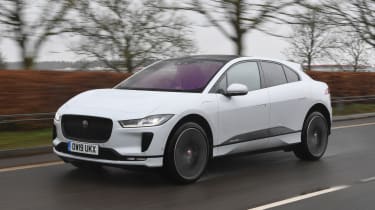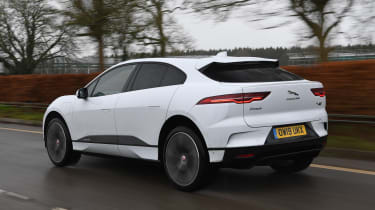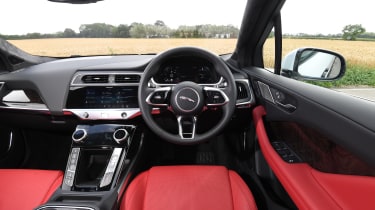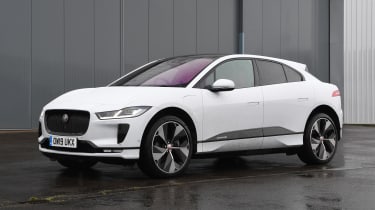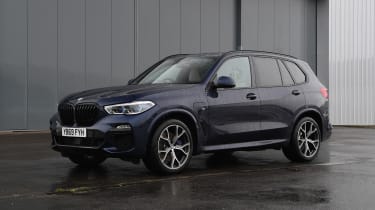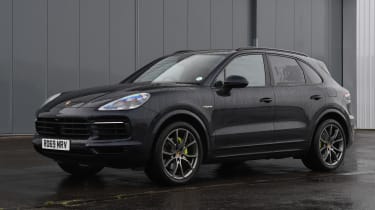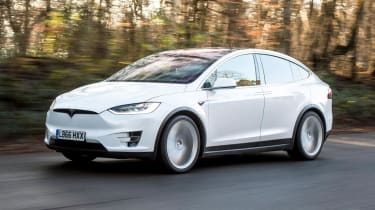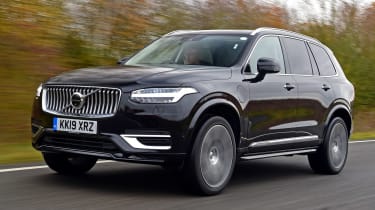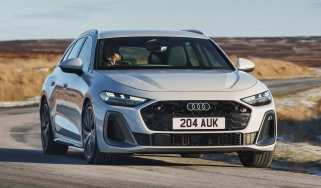BMW X5 vs Porsche Cayenne vs Jaguar I-Pace
Will the all-electric power of the Jaguar I-Pace reign supreme or will the BMW X5 or Porsche Cayenne come out on top? We test all three to find out...
Large premium SUVs have traditionally been best in diesel form, because this kind of engine tends to be the most effective at delivering lots of easy performance,
while still returning acceptable fuel economy in such a heavy car.
But buyers are increasingly being pushed away from this fuel. The dieselgate scandal saw the market move towards petrol, and recent changes to tax rates that favour electrified models have seen this trend grow even stronger.
That’s why we’ve brought together three large SUVs that will appeal to buyers looking to move away from diesel, starting with the new BMW X5 plug-in. It’s one of the few PHEVs that has an electric range of around 50 miles, so it’s a significant step for this type of car.
We’ll find out how it fares against the Porsche Cayenne E-Hybrid, an established upmarket plug-in SUV. But we’ll also discuss the Jaguar I-Pace, an all-electric model that could turn you away from internal combustion altogether.
BMW X5
| Model: | BMW X5 xDrive45e M Sport |
| Price: | £68,245 |
| Engine: | 3.0-litre 6cyl/e-motor, 389bhp |
| 0-60mph: | 5.6 seconds |
| Test economy: | 24.4mpg/5.4mpl |
| CO2: | 39g/km |
| Annual road tax: | £465 |
This new xDrive45e model brings electric power to BMW’s X5 range in conjunction with a 3.0-litre petrol engine. In M Sport trim it costs £68,245.
Design & engineering
The X5 PHEV’s 3.0-litre turbocharged straight six produces 282bhp and 450Nm of torque; while the latter figure is the same as the Porsche’s, it’s less powerful than the Cayenne and I-Pace. The total combined output of the BMW’s set-up, including the electric motor, is 389bhp, while the Jag has 395bhp and the Porsche a total of 456bhp.
Used - available now
However, the BMW’s key bit of tech is its 24kWh battery, which is 10kWh larger than the Cayenne’s. This gives it an all-electric range of 54 miles, which is more than twice what the Porsche manages. Of course, the full-EV I-Pace has a claimed range of up to 292 miles from its 90kWh battery, but that’s the total range – the petrol-assisted models here can go another few hundred miles once the battery is flat, and can fill up quickly at a petrol station. This is the benefit of a plug-in hybrid; you can be confident on long trips that you will be able to keep moving at all times. Yet as infrastructure improves, the all-electric option is getting more appealing by the day.
There are downsides to plug-ins though, and the BMW in particular. Due to a fairly slow 3.7kW on-board charger, it takes seven hours to fully charge at home.
The X5 uses BMW’s CLAR architecture, with double-wishbone front and multi-link rear suspension. There’s also adaptive air suspension as standard, and you can add four-wheel steering for £995 to help the big machine’s manoeuvrability.
The BMW’s cabin is finished to an excellent standard, on par with the Porsche’s and slightly ahead of the Jaguar’s. The interior design and materials in all three cars are of high quality; they
all feel deserving of their price tags from inside.
Parking sensors, a reversing camera, autonomous braking, heated leather seats, and climate and cruise control are all standard. There are also LED lights, a powered tailgate, sat-nav and a digital dash, plus wireless charging and Apple CarPlay.
Driving
The BMW’s two power sources are integrated superbly, which makes the car feel even more luxurious. At low speed the electric motor does all the work, pulling from a standstill strongly and with only a faint whining noise. In electric-only mode, the X5 is as quiet and refined as the I-Pace.
Once the engine turns on, this barely changes; the six-cylinder motor is extremely quiet. You notice that it’s working, but there’s nothing unpleasant about its smooth six-cylinder soundtrack.
In our tests, the X5 accelerated from 0-60mph in 5.6 seconds, which is plenty fast enough for a big SUV, but the Cayenne took just 4.5 seconds to do the same. That’s quite an achievement considering its weight, and only the slightly lighter I-Pace was quicker, taking 4.4 seconds. The BMW was narrowly behind the Porsche in our in-gear tests, so it has enough grunt to stay relaxing.
It’s the least dynamic of these three cars, though. The steering is no match for the superb set-up in the Cayenne, and the Jaguar also has a better-weighted set-up that’s more precise. The X5 rolls more in corners and its weight is noticeable, too, but then it’s more focused on ride comfort and refinement than handling, so this is to be expected.
It’s a great cruiser, and this is more important in a big SUV anyway. The standard air suspension deals with nearly all bumps and potholes very well, damping them away so they’re very much in the background, keeping things comfortable. If you reach the end of the suspension travel over a speed bump, it doesn’t have the suppleness of the Cayenne, but it’s more comfortable more of the time than both rivals here – especially because its seats are very plush and well positioned. The gearbox is smooth and refinement is superb, too.
Practicality
The X5’s size means it can feel a bit big on city streets, but the reversing cameras help with this, and its dimensions mean there’s lots of room inside.
The front seats are superbly comfortable and there’s lots of rear leg and headroom, so the X5 is great over long distances. Unlike the I-Pace, you don’t need to plan ahead when it comes to charging on journeys such as this because the petrol engine takes over.
Boot space is plentiful, and the split tailgate is a practical touch. While the X5’s 500-litre load volume is smaller than the Porsche’s 645 litres, the BMW has the most space of these three cars with all the back seats folded, at 1,720 litres.
Ownership
In our 2020 ownership satisfaction survey BMW finished 26th out of 30 manufacturers, well behind Jaguar’s ninth place (Porsche didn’t rank in Driver Power this year).
Standard autonomous braking helped the X5 achieve a five-star Euro NCAP safety rating. You can also add the £2,295 Driving Assistant Professional pack for cross-traffic warning, lane-keep assistance, semi-autonomous adaptive cruise control and a system that helps you swerve to avoid objects.
Running costs
Our depreciation experts predict that the X5 will retain 49 per cent of its list price after three years or 36,000 miles, while the Cayenne is predicted to retain 52.8 per cent of its value, and the I-Pace keeps an impressive 56.2 per cent, highlighting how EVs are becoming more popular.
These figures mean that the X5 loses the most in that period – £34,798 – and the Jaguar the least, at £30,693. The Cayenne splits the other two at £32,292. That’s still a large amount – yet the Jaguar makes both of its rivals look very expensive when you factor in fuel and tax costs, too.
Testers’ notes
“The X5’s 54-mile all-electric range will bring huge benefits for running costs. And if you’re a business user, company car tax will be reduced, because rates for PHEVs are now calculated based on this figure.”
Porsche Cayenne
| Model: | Porsche Cayenne E-Hybrid |
| Price: | £68,358 |
| Engine: | 3.0-litre 6cyl/e-motor, 456bhp |
| 0-60mph: | 4.5 seconds |
| Test economy: | 25.0mpg/5.5mpl |
| CO2: | 89g/km |
| Annual road tax: | £465 |
The Porsche Cayenne E-Hybrid costs from £68,358, and the model stands as a trim level in its own right. Is it a better bet than the BMW, though? You get a 3.0-litre V6 mated to a smaller 14kWh battery and electric motor, but a combined output of 456bhp is up on the X5’s 389bhp.
Design & engineering
The Cayenne’s MLB Evo platform means it shares parts with other luxury SUVs in the VW Group stable, including the Audi Q7, Bentley Bentayga and Lamborghini Urus. It features a multi-link suspension set-up at both the front and the rear, but it’s the Cayenne’s powertrain that’s the most interesting engineering aspect.
There’s a 3.0-litre turbo petrol V6 and an electric motor that’s supplied by a 14kWh battery, while power is sent to all four wheels through an eight-speed automatic gearbox. Air suspension is available, but costs £1,511, while Porsche’s Dynamic Chassis Control adds active anti-roll tech for a pricey £2,315.
Selectable driving modes let you choose how the car drives to some extent, as well as how the powertrain and battery behave. The ‘Hybrid’ setting combines the petrol and electric power sources automatically, while the ‘Charge’ and ‘Hold’ modes replenish and maintain battery charge respectively.
It takes six hours and 15 minutes to fully charge the Cayenne’s battery from a domestic supply using the standard on-board 3.6kW charger. Upgrade to the 7.2kW charger for £506, and this drops to around two hours when using a Type 2 connection, but it costs £210 for the cable. The battery is the smallest in this test and gives a range of 22 miles, so you will be relying on the petrol engine more than in the X5.
Cabin quality is a strong point because the Cayenne feels luxurious. It has a sportier feel than the X5, similar to the Jaguar in this regard, but build quality is better than in the EV model.
Climate control, sat-nav, Apple CarPlay, leather seats, LED lights, cruise control, parking sensors and a powered tailgate are all included, but the Porsche’s rivals offer even more standard kit.
Driving
As you’d expect from a Porsche, the Cayenne is the best car here to drive. The German brand has used its sports-car experience to create an SUV with sharp steering, loads of grip and plenty of agility. The Jaguar is good to drive too, but it can’t match the Cayenne for appeal. Even the driving position is as good as it gets in a large SUV.
The Porsche was also a strong contender in our performance tests. It took the E-Hybrid just 4.5 seconds to sprint from 0-60mph, which was helped by the launch control system, swift and smooth gearchanges and some assistance from the electric motor. The latter fills in where there are gaps in the engine’s performance, so it’s nearly as quick as the all-electric I-Pace. Both were well ahead of the BMW, which feels more cumbersome in comparison.
Air suspension is a pricey option, but if you’re going all-out with an SUV like this, then it’s worth getting. It improves the ride quality, and as a result the Cayenne has a great balance of ability. Body roll is controlled well, but the car remains settled at speed – although it’s not as comfortable as the X5, which has a softer set-up that deals with potholes and sharper bumps smoothly.
The Cayenne is about equal to the I-Pace when it comes to comfort, because both models ride with enough compliance for the most part, but you do start to notice body movement over bumpier roads.
As with both rivals, the Porsche is quiet inside, especially around town, where the electric motor provides near-silent running. The powertrain is well integrated and switches seamlessly
between electric and petrol drive.
Practicality
The Cayenne’s 645-litre boot is slightly smaller than the 656-litre load bay in the Jaguar, but it’s a better shape than its rival’s boot, with more height under the load cover. Both are bigger than the BMW’s 500-litre boot.
The Cayenne matches the X5 for rear-seat space, although you do sit lower than in the BMW; this also means there’s much more headroom than in the Jaguar, while legroom is better too.
There could be more cabin storage though, especially around the centre console for items such as phones, wallets and keys. Given the Cayenne’s size, you can also get rear-wheel steering (£1,448) which helps with low-speed manoeuvrability.
Ownership
Porsche didn’t rank in our 2020 Driver Power satisfaction survey, but safety kit on the Cayenne is solid. Autonomous braking is standard, but blind-spot monitoring and lane-keep assist cost £548 and £783 respectively. Still, the car received a full five-star rating from Euro NCAP.
Running costs
Fuel economy is tricky to calculate for plug-in hybrids, because it really depends on how much you plug in. We therefore recorded our mpg figures with completely empty batteries, so the PHEVs had a level playing field.
The Cayenne returned 25mpg on test, and the X5 returned 24.4mpg, which works out at £2,703 and £2,772 respectively over 12,000 miles. It’ll cost about £2 to charge the Porsche’s 14kWh battery and £3 to fully charge the X5’s 24kWh unit. The I-Pace costs about £12 per charge, so will cost just £624 over 12,000 miles, based on electricity at 13p per kWh.
Of course, the Porsche and BMW are designed to be plugged in. Do this religiously and their respective fuel costs will drop, but you’ll still have to cover a lot of distance on electricity to get close to the Jaguar’s costs. If you charge the battery daily and only do short trips, you could see three-figure fuel economy. But if you regularly drive longer distances, then a diesel could still be a more cost-effective choice.
Testers’ notes
"All of these cars use their electric motors in reverse to help with braking and top up the battery at the same time. It means you’ll gain a little extra range back, but only the Jaguar allows one-pedal driving.”
Jaguar I-Pace
| Model: | Jaguar I-Pace EV400 SE |
| Price: | £69,995 |
| Engine: | Dual e-motor, 395bhp |
| 0-60mph: | 4.4 seconds |
| Test economy: | 2.5 miles/kWh |
| CO2: | 0g/km |
| Annual road tax: | £0 |
A previous Auto Express Car of the Year, the I-Pace represents an alternative for those after a premium SUV in 2020. It’s fully electric, and in SE trim (our pictures show an HSE) starts from £69,995.
Design & engineering
The I-Pace sits on Jaguar’s D7e electric car platform. The battery is situated in the floor and supplies two electric motors – one on the front axle, one on the rear – to give 395bhp and 696Nm of torque. This means the I-Pace is four-wheel drive, just like its rivals, and as with the X5 and Cayenne, air suspension is available as an option.
With no engine to supply power when the battery runs out, you’ll need to consider charging options on longer trips. As infrastructure improves this will get easier, and the Jag accepts 100kW rapid charging. This means you’ll be able to top up en route, and an 80 per cent charge will take around 45 minutes.
On a less powerful 50kW charger this increases to 75 minutes, while using a home wallbox sees a full charge take 13 and a half hours, so you should be able to top up the battery overnight between commutes.
Jaguar claims a range of up to 292 miles from the 90kWh battery. That seems low when compared to how far the X5 and Cayenne can go on a tank of fuel, but consider how often you drive that far, and whether you’d cover such a distance without stopping for a break. The I-Pace should offer enough range for most owners in most situations.
The I-Pace’s cabin is nicely executed, with upmarket materials and plenty of standard features. It’s not quite as driver-focused as the Porsche, but it’s sportier than the X5’s set-up, and quality is good.
Sat-nav, Apple CarPlay and Android Auto are included, as are heated leather seats, LED lights, climate control and a range of safety kit, including adaptive cruise control.
Driving
While the Jaguar is fitted with a big 90kWh battery pack, it’s actually the lightest car here, at 2,208kg. That’s because it’s not compromised by also carrying a large petrol engine, gearbox, four-wheel-drive transmission and fuel tank.
With maximum torque available almost instantly, the Jag rockets off the line much quicker than its competitors. Acceleration tails off a bit approaching 60mph, where its rivals start to come back strongly, but the I-Pace was still the quickest from 0-60mph, at 4.4 seconds. This was 0.1 and 1.2 seconds quicker than the Cayenne and X5 respectively.
However, few will drive a big SUV like this – especially in the I-Pace, where range is precious, and hard acceleration sees this drop quickly. Instead, the time is a good indication of the level of flexibility a high-power EV such as this gives you.
Here’s where the I-Pace excels. With no gears there’s no pause in acceleration, and response from the electric motors is instant, so you have more than enough performance. You can even drive just using one pedal with the regenerative braking set to the higher of the two levels. When you lift off the accelerator, the motors work in reverse to slow the car and top up the battery, so on a country road, or even around town, you can blend in and out of the throttle without using the brakes.
It makes for smooth and relaxing progress, and this is helped by the ride. Even on the SE model’s standard 20-inch wheels, the damping of the optional air suspension is well controlled. There’s plenty of smooth suspension travel to deliver comfort, but also a good degree of support, so you can take advantage of the I-Pace’s well weighted steering. Interestingly, there’s as much feel as the Cayenne’s and it’s much more communicative than the X5’s.
Practicality
Take a look at the three cars’ dimensions, and the Jag’s footprint is much smaller than either rival’s. Yet the I-Pace offers more boot space thanks to its clever packaging, which sandwiches the lithium-ion battery within the wheelbase and under the cabin floor. A powered tailgate is standard on SE trim, helping practicality, and this opens to reveal 656 litres of space. That’s 11 litres more than in the Porsche, and 156 litres more than the BMW, which has its 24kWh battery located under the boot floor.
Fold the rear seats, and the I-Pace’s smaller footprint is more obvious because it loses out for maximum space. But few owners will use this potential; they’re likely to be more concerned with rear passenger room. Here the I-Pace is fine, even with its lower roofline and slightly more cramped footwells, courtesy of the sporty front bucket seats pinching some space. It isn’t as roomy in the back as either the BMW or Porsche.
Ownership
We’ve already seen BMW didn’t perform too well in our ownership survey, and while Jag’s mid-table result of 12th isn’t exactly brilliant for a premium brand, it’s better than its main German rival.
Safety tech is good in the I-Pace, with SE featuring emergency braking, blind-spot assist, adaptive cruise and a parking pack, which includes a 360-degree camera, cross traffic alert and park assist. Like its rivals, the I-Pace is a five-star Euro NCAP car.
Running costs
Here’s where the I-Pace – or any EV – scores big over even a plug-in hybrid. It emits zero CO2, so it will be free to run for company car users in the 2020/21 tax year.
Benefit-in-Kind rules have also been tweaked for this tax year to favour plug-ins, but they aren’t free. The BMW costs £1,637 for business users paying tax at the higher rate, because it can cover more distance on electric power than the Porsche, so it sits in the six per cent BiK band. The Cayenne falls into the 20 per cent group, so it will cost the same user £5,468. These are still low rates for big, premium SUVs, though.
Testers’ notes
“With no engine to drown out any tyre noise, the I-Pace’s refinement is really put under the microscope. However the Jag is superbly quiet and matches the BMW for quiet running.”
Verdict
First place: Jaguar I-Pace
The I-Pace proves that, if you’ve got the budget, right now is the time to go electric. The car’s performance and handling are brilliant for an SUV, while the battery tech also means super-cheap running costs and gives you access to more than enough range for most tasks, great charging capability and, thanks to the impressive packaging, surprising practicality. Jaguar’s infotainment set-up is still a letdown, though.
Second place: BMW X5
This X5’s plug-in powertrain sets the template for how big, hybrid SUVs should do it. The combination of six-cylinder smoothness, electrically assisted torque, and a zero-emissions range of more than 50 miles is a convincing one, while refinement, quality, kit and space back up this appeal. The X5 is not as good as either rival to drive, but it is comfortable and a great halfway house to EV ownership.
Third place: Porsche Cayenne
It's not that surprising that the Cayenne is one of the best-driving plug-in SUVs on sale. However, compared with the X5 it doesn’t make quite as convincing a case due to its shorter all-electric range. It’s spacious, beautifully built, and offers some great technology, but less of it is standard compared with its rivals. It’s also not quite as comfortable, but the refinement and brand image are both still great.
Also consider...
Tesla Model X
- Model: Tesla Model X Long Range
- Price: £87,190
- Engine: 2 x e-motor, 469bhp
If you want an SUV that’s a full EV, then the Tesla Model X is worth a look. It offers 314 miles of range and 0-60mph in 4.4 seconds, so it’s more practical and just as fast as the Jag, but it’s pricier. Build quality isn’t quite as good, but the infotainment is much better.
Volvo XC90
- Model: Volvo XC90 T8 Recharge R-Design
- Price: £67,495
- Engine: 2.0 4cyl/e-motor, 385bhp
The XC90 T8 was the first premium plug-in SUV that really made sense. It has a similar power output to the BMW, but the Volvo also features seven-seat practicality. The interior is beautifully trimmed, too.
Figures
| Jaguar I-Pace EV400 SE | BMW X5 xDrive45e M Sport | Porsche Cayenne E-Hybrid | |
| On the road price/total as tested | £69,995/£69,995 | £68,245/£80,545 | £68,358/£91,002 |
| Residual value (after 3yrs/36,000) | £39,302/56.2% | £33,447/49.0% | £36,066/52.8% |
| Depreciation | £30,693 | £34,798 | £32,292 |
| Annual tax liability std/higher rate | £0/£0 | £818/£1,637 | £2,734/£5,468 |
| Annual fuel cost (12k/20k miles) | £624/£1,040 | £2,772/£4,621 | £2,703/£4,504 |
| Ins. group/quote/road tax cost | 50/£1,029/£0 | 49/£663/£465 | 48/£918/£465 |
| Length/wheelbase | 4,682/2,990mm | 4,922/2,975mm | 4,918/2,895mm |
| Height/width | 1,565/2,011mm | 1,745/2,004mm | 1,696/1,983mm |
| Engine | Dual-electric motor | E-motor & 6cyl/2,998cc | E-motor & V6/2,995cc |
| Peak power/revs | 395/N/A bhp/rpm | 282/5,000 bhp/rpm* | 335/5,300 bhp/rpm* |
| Peak torque/revs | 696/N/A Nm/rpm | 450/1,500 Nm/rpm* | 450/1,340 Nm/rpm* |
| Total power/torque/battery capacity | 395bhp/696Nm/90kWh | 389bhp/600Nm/24kWh | 456bhp/700Nm/14kWh |
| Transmission | Single-spd auto/4wd | 8-spd auto/4wd | 8-spd auto/4wd |
| Fuel tank (battery) capacity/spare | 90kWh/repair kit | 69 litres/run-flats | 75 litres/repair kit |
| Boot capacity (seats up/down) | 656/1,453 litres | 500/1,720 litres | 645/1,605 litres |
| Kerbweight/payload/towing weight | 2,208/462kg/N/A | 2,510/640/2,700kg | 2,295/735/3,500kg |
| Turning circle | 12.4 metres | 12.6 metres | 12.1 metres |
| Basic warranty/recovery | 3yrs (60,000)/3yrs | 3yrs (unlimited)/3yrs | 3yrs (unlimited)/3yrs |
| Driver Power manufacturer/dealer pos | 12th/12th | 27th/25th | N/A |
| NCAP: Adult/child/ped./assist/stars | 91/81/73/81/5 | 89/86/75/75/5 | 95/80/73/62/5 |
| 0-60/30-70mph | 4.4/3.7 secs | 5.6/5.0 secs | 4.5/4.0 secs |
| 30-50mph in 3rd/4th | 1.5 secs | 2.3/2.6 secs | 2.0/2.5 secs |
| 50-70mph in 5th/6th/7th/8th | 2.2 secs | 4.1/5.3/6.7/9.3s | 3.3/4.2/5.5/7.9s |
| Top speed/rpm at 70mph | 124mph/N/A | 127mph/1,900rpm | 157mph/1,650rpm |
| Braking 70-0/60-0/30-0mph | 46.8/34.6/8.8m | 50.0/35.6/10.7m | 52.9/38.3/9.5m |
| Auto Express economy/range | 2.5 mi/kWh/225 mi | 24.4mpg/370 miles* | 25.0mpg/413 miles* |
| WLTP combined mpg/claimed range | N/A/292 miles | 188.3-235.4mpg/54 mi | 52.3-72.4mpg/22 mi |
| Actual/claimed CO2/tax bracket | N/A/0g/km/0% | 267/39g/km/6% | 261/89g/km/20% |
| Charging capacity | 3.7/11/50/100kW | 3.7kW | 3.6/7.2kW |
| Charging time | 27h/13h30m/75m/44m | 7hrs | 4hrs/2hrs |
| Auto/lane keep/blind spot/AEB | Yes/yes/yes/yes | Y/£2,295^/£2,295^/y | Yes/£783/£548/yes |
| Climate ctrl/cruise/leather/heat seats | Yes/yes/yes/yes | Yes/yes/yes/yes | Yes/yes/yes/£308 |
| Isofix/parking sensors/camera | Yes/yes/yes | Yes/yes/yes | Yes/yes/£480 |
| Met paint/LEDs/keyless/pwr tailgate | £700/yes/yes/yes | Yes/yes/£2,495^/yes | £774/yes/£816/yes |
| Sat-nav/digi dash/DAB/apps | Yes/yes/yes/yes | Yes/yes/yes/yes | Yes/yes/yes/yes |
| Wireless/CarPlay/Android Auto | No/yes/yes | Yes/yes/no | No/yes/no |


